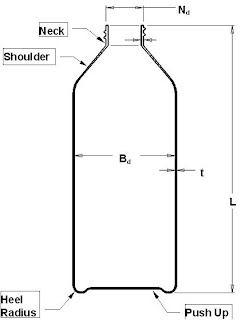Ensure Correct Preform Temperature Balance
Hot PET stretches more easily, cooler PET is more difficult to stretch.
Therefore the primary method of adjusting the positioning of material in the finished container is to use relative temperature in various parts of the preform.
If the temperature is balanced, the wall thickness of the container can be optimized and the overall strength of the container can be improved.
If the balance is incorrect, some areas may become thick leading to a mottled or grainy appearance while the thin, overstretched areas such as the corners may show pearlescence or crystallization.
Balance the temperature of the material within the preform to give the most equal strength in the finished product.
There are two major methods of doing this.
In the first method, injection velocity is used to control the temperature balance of the preform. Since most of the retained heat from the injection process is used in the blowing of the container, this method can have dramatic effects on the finished container.
Filling the injection cavity faster will have the effect of making the shoulder portion of the preform relatively cooler resulting in a container having a thicker shoulder area and a thinner heel.
Filling the injection cavity more slowly will allow less cooling time for the shoulder area of the preform (relative to the base) leading to thinner shoulders and a thicker heel.
This method is more critical where the preform is relatively long. Shorter preforms show less response.
The second method uses temperature adjustment at the conditioning station. The method of adjusting preform temperature depends on the type of conditioning system fitted.
Conditioning Systems
Oil / Water Conditioning Core With Electric Heating Pot
Electric Heating Core With Electric Heating Pot
Electric Heating Core With Oil / Water Conditioning Pot
Electric Heating Core With Split Type Oil / Water Conditioning Pot
Note that strength does not only come from wall thickness, it also comes from good bi-axial orientation of the material and physical design of the container. Therefore a container having equal wall thickness may not always have the best overall strength.
Thicker, unstretched areas of the container may have a mottled body or grainy shoulder appearance.
The conditioning station is not intended to re-heat the preform so the power and control is limited (in most container designs). The main purpose of this part of the machine is to provide a balancing function across multi-cavity molds and in some cases it actually provides additional cooling.
Therefore the primary method of adjusting the positioning of material in the finished container is to use relative temperature in various parts of the preform.
If the temperature is balanced, the wall thickness of the container can be optimized and the overall strength of the container can be improved.
If the balance is incorrect, some areas may become thick leading to a mottled or grainy appearance while the thin, overstretched areas such as the corners may show pearlescence or crystallization.
Balance the temperature of the material within the preform to give the most equal strength in the finished product.
There are two major methods of doing this.
In the first method, injection velocity is used to control the temperature balance of the preform. Since most of the retained heat from the injection process is used in the blowing of the container, this method can have dramatic effects on the finished container.
Filling the injection cavity faster will have the effect of making the shoulder portion of the preform relatively cooler resulting in a container having a thicker shoulder area and a thinner heel.
Filling the injection cavity more slowly will allow less cooling time for the shoulder area of the preform (relative to the base) leading to thinner shoulders and a thicker heel.
This method is more critical where the preform is relatively long. Shorter preforms show less response.
The second method uses temperature adjustment at the conditioning station. The method of adjusting preform temperature depends on the type of conditioning system fitted.
Conditioning Systems
Oil / Water Conditioning Core With Electric Heating Pot
Electric Heating Core With Electric Heating Pot
Electric Heating Core With Oil / Water Conditioning Pot
Electric Heating Core With Split Type Oil / Water Conditioning Pot
Note that strength does not only come from wall thickness, it also comes from good bi-axial orientation of the material and physical design of the container. Therefore a container having equal wall thickness may not always have the best overall strength.
Thicker, unstretched areas of the container may have a mottled body or grainy shoulder appearance.
The conditioning station is not intended to re-heat the preform so the power and control is limited (in most container designs). The main purpose of this part of the machine is to provide a balancing function across multi-cavity molds and in some cases it actually provides additional cooling.



Comments